Rick Bailey's Blog: Stuff happens, then you write about it, page 12
August 31, 2023
Hold It Right There

Aristotle, 14; Charles Darwin, 5.
It sounds like the final score in the big-names-in history wrestling contest. Aristotle destroys Darwin.
It’s actually the number of human emotions these thinkers could think of. Both list fear and anger. Aristotle distinguishes between shame and shamelessness; Darwin doesn’t bother with either of those. Darwin includes love; Aristotle, friendship.
Fast forward to the early 20th century, there is a giant leap in human emotion theory, when psychotherapy gets rolling, and shrinks list as many as 90 emotions. (That must have kept them—and their clients—very busy.) Recently, University of California psychologist Paul Ekman has returned to basics, listing 7 human emotions. He actually uses a system (the facial action coding system, or FACS) for recognizing and coding them. Happiness, sadness, surprise, fear, anger, disgust, and contempt. That’s what we humans emote. And he knows it when he sees it.
This week we’ve been faced with a range of emotions out here in Mariposa. Rapture, disgust, fear, and regret.
Yesterday Tizi and I picked Kerr apples. These beauties hang on eight trees in the row closest to our kids’ house. The Kerr apple is in the crabapple family, about 1” to 1 ½ inch in diameter. They are tart and sweet at the same time, and they are gorgeous to behold. As they ripen, they become dark red; given sun and time, that color deepens to a ravishing burgundy, bordering on purple.

They don’t hang on branches so much as bunch like grapes, and they come off the tree with dark green leaves you leave behind on the ground, if possible. You can’t look upon these apples and not feel moved by their natural beauty. The emotion, in a word: rapture.
Before picking yesterday Tizi and I drove into town and had breakfast at a place called Happy Burger. It was an unhappy breakfast. I love the ambiance. In a stroke of genius, someone decided old record album covers could serve as wallpaper (and ceiling paper). The whole time we were eating I looked up and around. Mitch Miller, Julie Andrews, Nat King Cole, Wilson Picket, Roy Clark, Englebert Humperdinck, Tom Jones, Jack Jones. The Beach Boys. Gerry and the Pacemakers. I kept pointing them out to Tizi.
“Look, there’s Glen Campbell.”
“Look, Dean Martin.”
“Look—.”
“That’s enough,” she said.
According to my facial action coding system, acquired in years of marriage, I saw she was in a state of disgust. She was patting down her hash browns with a paper napkin, for the third time, trying to soak up the grease. “We’re not coming back here,” she said.
Because of those album covers, put me down for regret, which none of the emotion scientists include.
“Steve’s breakfast,” she said, “is way better.”
Attached to a gas station and a small general store, Steve’s is full of locals. They belly up to tables, eat and gab and laugh. The atmosphere is friendly, companionable. Even an amatuer user of the FACS can read happiness. Except for the signs and posters hanging on the walls. Whereas Happy Burger’s decor elicits delight with faded photos of entertainment icons (will you get a load of Wayne Newton’s hair!), the theme in Steve’s is all Second Amendment. It’s unsettling.

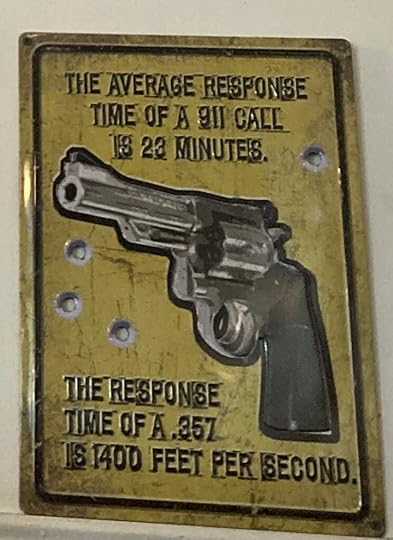
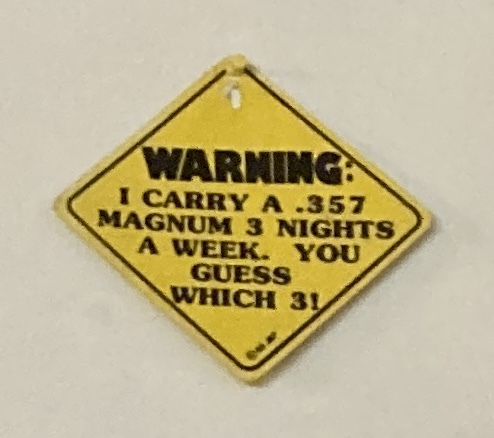
“Everyone out here has guns,” David says when I mention the signs on the wall. In the West he means. In Mariposa. “Almost everyone carries.”
I tell him about a guy I talked to in the tasting room on Saturday, who said there are heroin addicts galore out there, breaking into homes, and if they break into his house, he said, their next stop will be the medical examiner.
“I don’t know about the heroin addicts,” David says, “but basically everyone out here is just waiting for a break-in. They want to use their guns..”
“Assault weapons?”
“Lots of them. To protect themselves from the government.”
Mariposa is an old mining town.. The county, also named Mariposa, was established in 1850. There are lots of small communities in the county: Mariposa, Midpines, Bootjack, Catheys Valley, El Portal, Hornitos, Coulterville, Fish Camp, and Wawona. Mariposa in particular has a certain old West 19th century charm. No one locks their doors.
The town, and the county, currently feels threatened. And not just by phantom heroin addicts.
Siege mentality is too strong a term. Let’s just say Mariposa residents like things the way they are. That feeling has been in bold relief recently, with dubious thanks to Terramor.

Right now on every country road you drive in the area—Triangle, Darrah, Tiptop, Wass—in front of homes you see the signs: Stop Terramor. Terramor is an outdoor resort-building operation, selling “glamping” to people with campers. The tagline on the Terramor website (they sell their program, with similar resistance, in other localities around the country) is “Start planning your adventure.” To residents in Mariposa County, Terramor will be an assault on a way of life, impacting water resources, bringing pollution, traffic, and increased fire hazard.
They’re fighting Terramor. They’re preserving their way of life.

”Can you imagine these trees in the spring?” Tizi says.
We’re picking in the late afternoon. I’m on an eight-foot ladder grabbing fruit in the top of a Kerr. She’s in the lower branches and picking up drops as well. Late afternoon the sun arrives at a point in the sky, you’re no longer baking while you pick. There’s a breeze. Today the sky is perfectly blue, which we remark upon every so often. There must be a fire somewhere—in Oregon or Washington, in Canada. That’s a new normal. Today is the old normal.
Happiness gets little mention in emotion science. Maybe not until the 20th century. Maybe not until an American adds it to his list. Happiness is so frivolous, so transitory, unlike the more visceral emotions, like anger, fear, or disgust. “The fact is that the commitment to happiness in Western culture is relatively modern,” writes Peter N. Stearns in Harvard Business Review. “Until the 18th century, Western standards encouraged, if anything, a slightly saddened approach to life,”
“It’s a good day,” I say. When I come down off the ladder, I reach in my pocket for my phone.. “Hold it right there,” I say. She’s reaching for the fruit. It’s a good picture. We’ll want to remember this day. We were happy.
August 27, 2023
Lighten Up
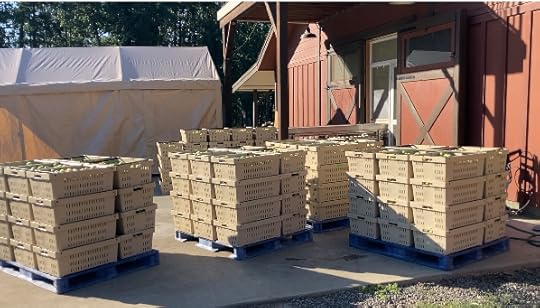
I’ve been using my Kindle as a flashlight the last couple mornings. At 4:30 a.m. the display lights my way from a bedroom to a hallway to the kitchen, where I can light a light and make some quiet coffee and pull on shirt and pants.
For 7-10 days we’re staying with our son and his wife in the Sierra Nevada mountains, at their 800-tree apple orchard, where we have come to visit and to pick apples. Yesterday morning Tizi and I picked 600 pounds of Yarlington Mills. It was work. It was good old-fashioned honest manual labor, and I was muscle weary and dead tired when we finished. (Long days of more work lie ahead.) I may have been tired, but I was done sleeping by 4:30 this morning anyway. I’m cursed with the habit of waking up preternaturally early (to use a fancy word I have always loved—I honestly don’t get that “preter” prefix, but I’ll take it). To get up and wander about someone’s house, even a close relative’s, at that hour feels anti-social. The clank of a spoon is a gong, the flush of a toilet is a roaring waterfall, a cough or sneeze is a car crash.
Mornings, wherever I am, are mostly for reading. Just now I’m reading something on Kindle. What is it? I don’t remember the title. A bad thing about Kindle: you don’t look at a book cover every time you read. You’re not reminded: Oh, it’s Flight Behavior by Barbara Kingsolver. When you open Kindle it goes directly to the last page you read. Then you click a few times to get to the title page.
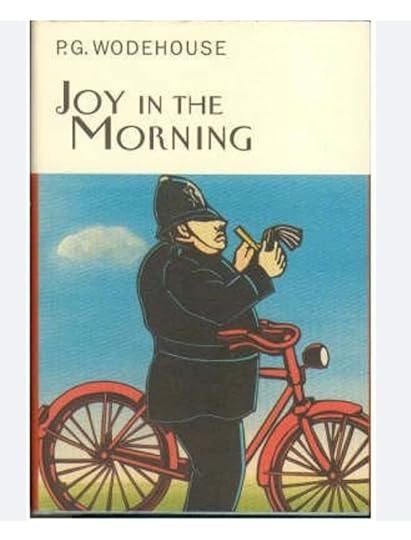
Right now it’s Joy in the Morning, by P. G. Wodehouse, an aptly named bunch of British nonsense published in 1946. This morning I’m making myself read this book (forced joy), determined to hang in there for 30 minutes or so, because when I read in bed at night, especially after a day of apple picking, I can get through only 3-4 pages—in relatively, I might even say preternaturally, large font on the display for old eyes reading in bed at night. Three pages and out. Next time I open to the book, I think: What happened? What’s going on in this story? Where were we? So this morning, I’m focused on Joy.
Kingsolver engaged large themes: gender politics, environmental change. Wodehouse is all froth and fun. The story is so weightless I embarrass myself reading it. The fun is that I’m keeping company with oddly named characters: Nobby Hopwood, Stilton Cheesewright, J. Chichester Clam, Boko Fittleworth, Barmy Fotheringay-Phipps. And reading along, provided I’m awake, I stumble upon sentences like this:
“The first sight of Boko reveals to the beholder an object with a face like an intellectual parrot.”
“This man of letters is a cross between a comedy juggler and a parrot that has been dragged through a hedge backwards.”
“Like so many substantial citizens of America, he had married young and kept on marrying, springing from blonde to blonde like the chamois of the Alps leaping from crag to crag.”
“It isn’t often that Aunt Dahlia lets her angry passions rise, but when she does, strong men climb trees and pull them up after them.”
The story is so silly, so weightless, of such little moment, it feels like a waste of time. Shouldn’t I be reading Dostoyevsky?
No.
Embrace the silliness. You can be serious later.
#
Yes, a cough can be a car crash.
I get coughs these days that can’t be stifled. The cough is triggered by something going on, or not going on, in my gullet. I recall my father saying one time, “Floyd has a difficult time swallowing.” Floyd Campbell, his best pal, couldn’t swallow? I was young. They were old. I couldn’t imagine. You swallow how many times a day, when you have to, a bit of saliva, a glass of water, a bite of sandwich. It’s like heartbeat. It just happens.
But lately I’ve been feeling liquids, just a few drops, taking a wrong turn, going windpipe-ward rather than esophagus. Muscles soften, fail to do their automatic work. Breath knows where to go, food and drink know where to go, but there it is, the fact of being an older person. A sip of coffee, a small sluice of water, there can be an errant trickle down the trachea. Resulting in a choke dressed up as a cough.
“Reductions in muscle mass and strength are well known complications of advancing age.” Thus reports the National Library of Medicine. And: “In fact, people over 65 years of age have seven times higher risk for choking on food than children aged 1–4 years of age.”
So watch out.
It happens this morning. A sip of water, noise. I disturb the peace.
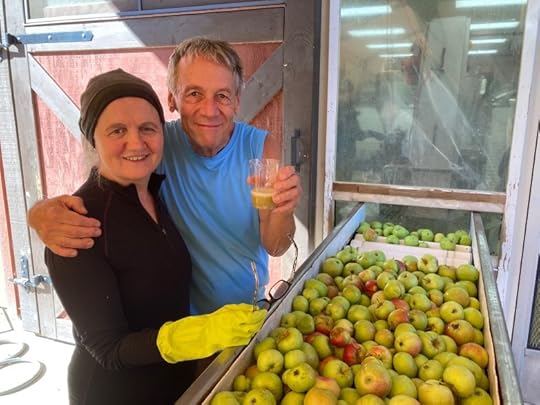
My muscle mass will be tested today. We’ll be pressing apples, making cider. You don’t just press a few. Think tons of apples. By the end of the day, three tons.
It’s a complex production. On one end, the station Tizi and will work, it’s lifting and dumping. Between 9:00 a.m. and 1:00 p.m. I’ll lift roughly 3000 pounds of apples, in lugs (appropriately named) that weigh roughly 35 pounds each, dumping each lug on a conveyer that carries the apples—sorted, screened for spots of rot and bug bite—to the press. Inside the barn, David and his associate Cody take over, minding the machinery that crushes the apples and pumps their juice to containers where fermentation will begin.
It’s repetitive work, it’s mindless work, and it is glorious.
At one point, David steps outside and hands us a clear plastic glass. In it, the juice. “This is the only apple we press,” he says, “that makes green juice.”
It’s cool and green and delicious. It goes down easy, and it goes where it’s supposed to go. The muscles in my throat, like those in my back and my arms, know what to do.
After such exertion you sleep like the dead. That too is glorious. Then, awake. Kindle light, coffee, some reading. And daybreak.
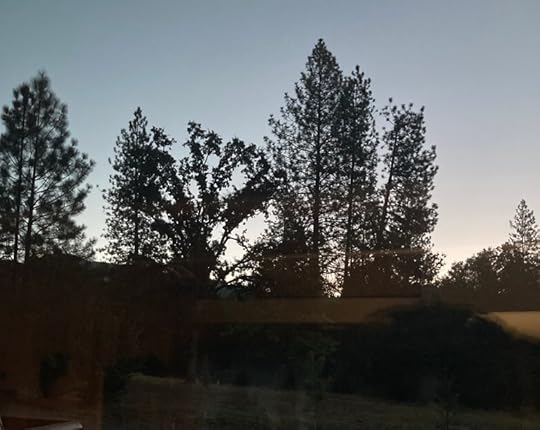
August 25, 2023
Ride It
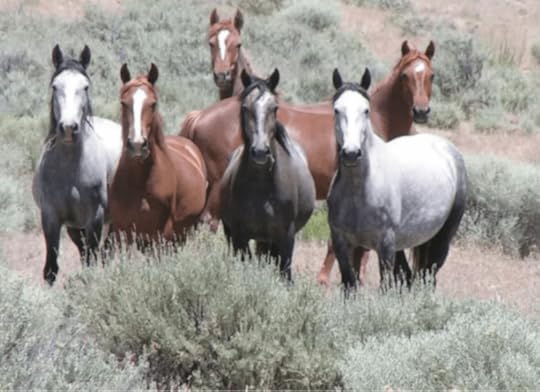
“That’s two,” Tizi says.
“You’re counting?”
Whatever she murmurs in response I can’t hear. Because even with my hearing aid cranked to HIGH, I can’t hear murmur in the car. And besides, this I don’t really want to hear.
It’s a little tense at the moment. We could be counting wild horses. When we drive out to California to visit our son, we take this desert route on purpose, to see the horses, starting 70 miles west of Elko, Nevada, on I-80 to Battle Mountain, so named thanks to a skirmish between marauding Californians and native tribes in 1850. A few miles east of Battle Mountain you see the giant BM on the mountain side. The Californians prevailed. Heading south on route 305 we come to route 50, along which on Bureau of Land Management land, roughly 2000 horses run wild.
Routes 305 and 50 are two-lane roads. And all the routes after them taking us to Yosemite will be two-lane, through beautiful high desert. A center line is visible, the road surface is good, though noisy in places (hence the muffled murmur). To say these roads are little traveled is an understatement. Between BM and nowhere, there’s nothing for miles.
This morning, when we took the exit off I-80 and started down route 305, I looked at the gas gauge. Got enough? Tizi asked. Well I guess, I said.
Now I’m not so sure. Where I stop in the middle of the road, there are a dozen wild horses standing thirty feet off the shoulder.
“Horses?” Tizi says. As in: is that why you’re stopping.
“We have a decision to make,” I say.
She frowns. “How much?” she asks.
“About a quarter tank.”
She gets out of the car, walks across the road, crosses the shoulder to take a few pictures. I’m about to reach for my phone when I see a blue dot in my rearview mirror. Forty-five minutes down 305 and now route 50, we’ve seen one car. This one makes two. I take a position at the back of the van and hold out my hand. It’s the universal stop-please-help signal. At first it does not seem to be working. Then, blue begins to slow.
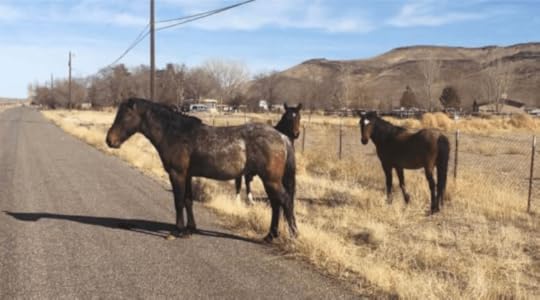
The driver, a woman, runs the passenger window down.
“You shouldn’t park here,” she says. “It’s dangerous.”
“How far to a gas station?” I say.
She thumbs in the direction of BM, where we just came from. I point toward the future: more horses, more nothing, and then what.
She tells me again I shouldn’t park here. “There’s a lot of mine traffic,” she says.
I ask again. Gas?“
“Probably Austin. It’s about 60 miles down the road.” In case I missed it, she shakes her head in irritation. Michigan license plate, horse gawkers, stopped in the middle of the road.
“Austin,” I say when Tizi gets back in the car.
“How far?”
“About sixty miles.”
“They’re beautiful,” she says. Meaning the horses.
“I think we can make it,” I say.
That’s when she says: That’s two. Twice I’ve taken us to the edge. Out here, obviously, is no place to run out of gas. No place is. But this place is extremely no place.
Okay, so we had a bad breakfast. It was our third stay in this hotel back in Elko. I remembered the buffet as adequate.
This morning at 6:00, when we left the room and walked down the hall, she asked if there would be eggs. I said I thought so. I said I remember the buffet as more than adequate.
It was not. Extremely not. A breakfast like this separates the Americans from the Italians. Yes, there are eggs, in sandwiches that were made within the last 24 hours and shelved in small single-serving paper bags. If you rip open a little pouch of hot sauce and squirt it on the sandwich, it’s better than not bad. The cereal mix I make, spooning granola, walnuts, and what I think are bran flakes (Tizi swears they are Frosted Flakes, to her a sugary abomination) is satisfactory. But I’m willing to bet the Meadow Gold 2 percent milk, with no expiration date on the carton, saw better days a day or two ago. When the conveyor belt toaster that warms two halves of an English muffin completes its task, half the muffin tips off the track and falls on the floor. Under these adverse circumstances, I can still make a meal. Tizi cannot.
So when we get underway again out there in desert, setting our sights on Austin, that is to say, hoping to set our sights on it, she is not in her best humor.
“Beautiful along here,” I say.
“Yup.”
“I could swear last year we saw the wild horses on the other side of the road,” I say.
“Hmmm.”
“You can tell they’ve had a lot of rain. It was nowhere near this green last year.”
I know it’s dangerous to stop in the middle of the road, but for the next thirty minutes, we see only two cars. Both coming at us. None going where we’re going.
What if there’s no gas in Austin? I don’t want to, but I begin playing out the scenario and plan of action. The scenario is clear; the plan of action is not.
“This is a Pony Express route,” I say. “I think the Middlegate stop was a Pony Express stop.”
Middlegate is somewhere down the road, beyond Austin, deeper into the desert. The gas gauge sinks well below quarter tank. Thirty miles to go. What if there’s no gas in Austin. I begin to fantasize about seeing the Austin city limits, passing Austin community schools, waving at the chairman of the Austin Chamber of Commerce. A thriving community out in the middle of nowhere. Finally we round a curve. Austin does not come into view, but I see a sign, white lettering on a blue background. “This city adopted by…” A sorority that picks up litter. That bodes well. Where there’s a sorority, where there’s litter, there must be gas.
There is.
The next leg, route 50 to route 361, is lonely but not fraught. I drive 80 mph on two-lane 50, full of gas, full of sass. We see four antelope. That buoys our spirits. We see the sign for Rawhide. Thirty miles off route 50, out deeper into nowhere. I wonder if there would be a statue of Rowdy Yates, the Clint Eastwood character in that TV show. We pass another historical marker for a Pony Express stop.
“How about those guys,” I say. “Riding out here?”
At Middlegate we stop at an inviting hovel. Out here any sign of civilization is inviting. She peels and eats a peach we brought from Michigan. I take a few pictures. We’re good again.
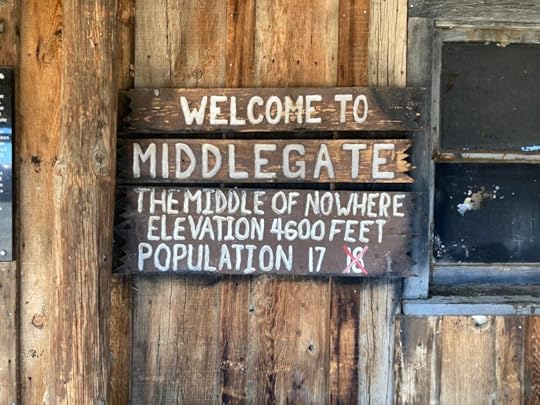
August 24, 2023
Facsimiles
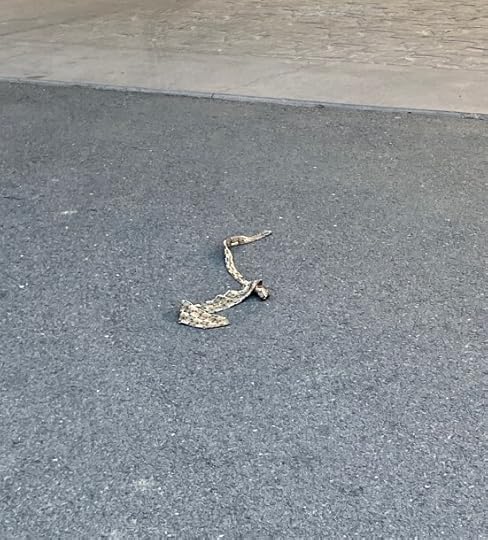
I couldn’t be this lucky, I think to myself. What are the odds of finding a rattlesnake skin that’s been sluffed off, left behind in one piece, and in pretty good condition? But there it is, of all places on the driveway of the Fairfield Inn, in Laramie, Wyoming. I figure, Well yeah, I’m out west. This is Laramie. It’s where rattlesnakes live. And cattle rustlers and sherrifs and matronly good-hearted bar maids and well-dressed hanging judges.
Modern man takes a picture. I’m reaching for my phone as I walk toward the skin, thinking we could take it home, frame it, hang it above the mantle. What better memento.
Then the skin comes into focus: it’s a necktie. Some poor guy packed a sloppy suitcase, or lost his job, or quit his job, or left the hotel in a hurry after a dangerous liaison. What does modern man do? I take a picture anyway.
I’ve got cattle rustlers and sherrifs and matronly good-hearted bar maids and hanging judges on my mind because I’ve just feasted on the Fairfield Inn complimentary breakfast, and while eating it, enjoyed watching black-and-white reruns of a television show called Laramie. I watched it when I was a kid. The show ran from 1959 to 1963. It starred John Smith (born Robert Errol Van Orden), Robert Fuller (born Leonard Leroy Lee), Hoagy Carmichael (that’s his real name), and Spring Dell Byington (that’s her real name). This morning it was on the big screen in the hotel breakfast room. The sound was turned off, which I very much appreciated. In the episode showing there was generic trouble afoot. I couldn’t help but notice how scrubbed and pristine the black and white scenery was, how well dressed the characters were. It was another era of television, of westerns, sans dirt, sans whiskers, sans whores and gore and the profanity you see and hear in Deadwood or Hateful 8.
“This is good,” I said to Tizi. On my third trip to the board, I’d scooped up scrambled eggs with salsa verde. “Want some?”
I knew the answer. First she shriveled, then said, “Powdered eggs.”
“Is that even a thing?” In the army maybe? And not anymore?
She emitted a barely audible Ugh, pointed at my plate. “What’s that green stuff?”
“This ‘green stuff’ is salsa verde.”
Ugh. Again. She frowned at her plate. “I think this is artificial bacon.”
“From this day forward, I will always have scrambled eggs with salsa verde,” I said. “It’s that good. And look: Nutella. They’ve really got it going here.”
On regular intervals a kind lady emerged from the backroom and replenished napkins and waffle mix and artificial bacon. She also cleared tables.
“This was terrific,” I said when she walked by.
“Why thank you!” she said.
On screen Spring Dell Bylington, her brow furrowed, was imploring the sheriff and hanging judge for help.
“Maybe later,” Tizi said, “we can find some good food.”
After breakfast we drive 600 miles. As is our habit now, we look up in the sky and check for smoke. Day before yesterday, leaving Des Moines, we debated: was that haze or smoke? Or was it good old-fashioned fog? This morning there’s a brown strip across the horizon, an inversion layer. Under scattered, not quite blue skies, we cross the high desert, pass through Salt Lake City, and run the salt flats toward Bonneville at high speed. Finally in Nevada, we see it: blue sky. Deep blue. All blue. With large fluffy white clouds that cast wide shadows across the terrain.
In Elko, where we’ll spend the night, we search—for fresh vegetables and for shade.
The former, I know, is a fool’s errand. We ask the clerk-in-training at the hotel desk where Tizi can find some nice fresh vegetables. The clerk is stumped. I imagine a French fry is the closest she’s come to such fare.
“I mean,” Tizi says, “like an omelet?”
Clerk-in-training number two, also not long out of pigtails, appears and says with confidence: Try JR’s.
JR’s is a casino restaurant. They serve breakfast. The vegetables in Tizi’s vegetable omelet were fresh once, then frozen. She is neither happy nor unhappy.
My tacos, on the other hand, are a triumph, eliciting pleasures exceeding those I experienced this morning scarfing scrambled eggs and salsa verde.
Back at the hotel, we drive around the parking lot twice, looking for shade. There are a few minor trees, some stunted bushes, gravel, and cement. No significant shade. Shade matters to her—more than it should, I think. But she’s had a bummer dinner, so I circle the parking lot once, then twice, and begin a third rotation when she points. “There.” At the end of the building, shade possible tomorrow afternoon.
“It will be cool in the morning,” I tell her.. ”We’ll leave early enough, shade won’t matter.”
Morning. Breakfast. I, for one, can’t wait. Laramie will be hard to beat.
Hard to Beat

I couldn’t be this lucky, I think to myself. What are the odds of finding a rattlesnake skin that’s been sluffed off, left behind in one piece, and in pretty good condition? But there it is, of all places on the driveway of the Fairfield Inn, in Laramie, Wyoming. I figure, Well yeah, I’m out west. This is Laramie. It’s where rattlesnakes live. And cattle rustlers and sherrifs and matronly good-hearted bar maids and well-dressed hanging judges.
Modern man takes a picture. I’m reaching for my phone as I walk toward the skin, thinking we could take it home, frame it, hang it above the mantle. What better memento.
Then the skin comes into focus: it’s a necktie. Some poor guy packed a sloppy suitcase, or lost his job, or quit his job, or left the hotel in a hurry after a dangerous liaison. What does modern man do? I take a picture anyway.
I’ve got cattle rustlers and sherrifs and matronly good-hearted bar maids and hanging judges on my mind because I’ve just feasted on the Fairfield Inn complimentary breakfast, and while eating it, enjoyed watching black-and-white reruns of a television show called Laramie. I watched it when I was a kid. The show ran from 1959 to 1963. It starred John Smith (born Robert Errol Van Orden), Robert Fuller (born Leonard Leroy Lee), Hoagy Carmichael (that’s his real name), and Spring Dell Byington (that’s her real name). This morning it was on the big screen in the hotel breakfast room. The sound was turned off, which I very much appreciated. In the episode showing there was generic trouble afoot. I couldn’t help but notice how scrubbed and pristine the black and white scenery was, how well dressed the characters were. It was another era of television, of westerns, sans dirt, sans whiskers, sans whores and gore and the profanity you see and hear in Deadwood or Hateful 8.
“This is good,” I said to Tizi. On my third trip to the board, I’d scooped up scrambled eggs with salsa verde. “Want some?”
I knew the answer. First she shriveled, then said, “Powdered eggs.”
“Is that even a thing?” In the army maybe? And not anymore?
She emitted a barely audible Ugh, pointed at my plate. “What’s that green stuff?”
“This ‘green stuff’ is salsa verde.”
Ugh. Again. She frowned at her plate. “I think this is artificial bacon.”
“From this day forward, I will always have scrambled eggs with salsa verde,” I said. “It’s that good. And look: Nutella. They’ve really got it going here.”
On regular intervals a kind lady emerged from the backroom and replenished napkins and waffle mix and artificial bacon. She also cleared tables.
“This was terrific,” I said when she walked by.
“Why thank you!” she said.
On screen Spring Dell Bylinton, her brow furrowed, was imploring the sheriff and hanging judge for help.
“Maybe later,” Tizi said, “we can find some good food.”
After breakfast we drive 600 miles. As is our habit now, we look up in the sky and check for smoke. Day before yesterday, leaving Des Moines, we debated: was that haze or smoke? Or was it good old-fashioned fog? This morning there’s a brown strip across the horizon, an inversion layer. Under scattered, not quite blue skies, we cross the high desert, pass through Salt Lake City, and run the salt flats toward Bonneville at high speed. Finally in Nevada, we see it: blue sky. Deep blue. All blue. With large fluffy white clouds that cast wide shadows across the terrain.
In Elko, where we’ll spend the night, we search—for fresh vegetables and for shade.
The former, I know, is a fool’s errand. We ask the clerk-in-training at the hotel desk where Tizi can find some nice fresh vegetables. The clerk is stumped. I imagine a French fry is the closest she’s come to such fare.
“I mean,” Tizi says, “like an omelet?”
Clerk-in-training number two, also not long out of pigtails, appears and says with confidence: Try JR’s.
JR’s is a casino restaurant. They serve breakfast. The vegetables in Tizi’s vegetable omelet were fresh once, then frozen. She is neither happy nor unhappy.
My tacos, on the other hand, are a triumph, eliciting pleasures exceeding those I experienced this morning scarfing scrambled eggs and salsa verde.
Back at the hotel, we drive around the parking lot twice, looking for shade. There are a few minor trees, some stunted bushes, gravel, and cement. No significant shade. Shade matters to her—more than it should, I think. But she’s had a bummer dinner, so I circle the parking lot once, then twice, and begin a third rotation when she points. “There.”
“It will be cool in the morning,” I tell her.. ”We’ll leave early enough, shade won’t matter.”
Morning. Breakfast. I, for one, can’t wait. Laramie will be hard to beat.
August 23, 2023
iThink
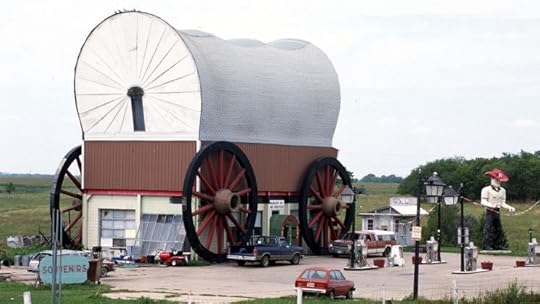
“Don’t forget the cows,” Tizi says.
How could I? If I think Iowa, I’ll think corn; in Nebraska, it will be cows. Since we crossed the state line they’ve appeared on hillsides, in fields, standing, sitting, lying. A few lucky ones, wading. It’s hot. There’s a hurricane in in the Pacific—Hilary, weather people are calling it/her, a once-in-a-lifetime event. It’s just been downgraded to a “tropical disturbance.” Well yes, I imagine 12 inches of rain in Los Angeles would be plenty disturbing. Here in the Midwest they’ve issued an excessive heat warning. It will be 114 in Des Moines tomorrow.
Most of the cows are black. They dot the hillsides. Where they congregate, I’ve noticed, a mob mentality takes hold. Lead cow indicates: I’m turning my back to the Interstate or I”m facing that scabby tree by the pond, or I’m walking up this hill, and they all fall in line. There’s not a non-conformist cow among them. Like birds on a wire: Guys, perch looking West. And they do.
I won’t forget the cows.
There’s a lot I want to remember as we burn up the road. We’re in no great hurry, but there’s a great distance to cover. Everything flies by. There is a too-muchness about it all.
I don’t want to forget crossing the Platte River, which, Google tells me, trappers used and both the Oregon and the Morman Trails followed during the westward expansion. (Mystic rivers! A couple years ago we floated the Snake. The year before that, when we crossed the Missouri River, leaving Minnesota entering South Dakota, I was tempted to pull over. Along Interstate 70, the Colorado River calls to you. I’m history. Slow down, you dolt.) In Nebraska the Platte reminds you it’s there, branch after branch.
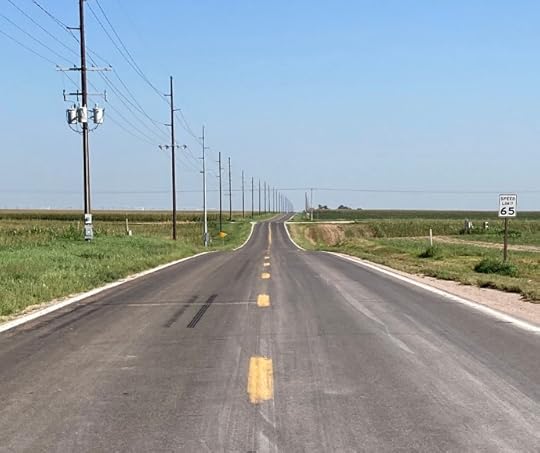
I don’t want to forget the names of towns. Welcome to Friend, Nebraska. Have you been to Montezuma? How about Happy? In another life, if it were a very long one, we would take the exit in Milford and check out the giant covered wagon, spend a little time at the Plainsman museum. Strategic refueling helps. If you stop, make it count. Yesterday we refueled in Waco, Nebraska, at the scuzziest gas station I’ve ever set foot in, with a pothole-filled drive I thought I might bust an axle driving over. And where was Waco? No town in sight. It must have been down that neglected two-lane one way or the other. There was no telling, and I didn’t ask.
Once in a while, I pick up my phone and record a detail. I take a note, voice to text. “The blond cows look like rocks lying in the fields,” I say, and it’s saved for future contemplation. But at 81 mph, even on a long straightaway, I don’t like touching my phone. It’s dangerous. Coming soon, I hope, an app for that. We need an iThink app that records your thoughts. Thought to text. You think it, the app writes it. I could be journaling as I drive, capturing every passing curiosity. A town called Funk, a town called Wynot. It would be messy, I know. Thoughts are chaotic and multi-directional. You wouldn’t want the app to record everything (“let not light see my deep and black desires”). You would need commands. This thought, not that one. “Hey, Siri, I’m thinking…” A command like that and bingo! Thought capture. “Hey Siri, I thinking the stick man face I saw in Laramie.”
A lot of this time in the car, we ride in silence. Alone in our thoughts. Long periods of meditation and reflection, broken by observations. “I wonder if Frank will take that job.” “When will Gabriel have those teeth pulled?” “That place we stayed in Oklahoma City was nice.” We’ll chat a few minutes, then return to our thoughts. I know we could be doing something—listening to books, listening to music, tuning in podcasts. But the idleness is full and rich.
We get snippets of NPR. Radio reception waxes and wanes, mostly wanes. Tizi suggests podcasts.
“Let’s get that going, she says. “We could listen to Rachel Maddow.”
Well, yes we could. I’m interested in what she has to say. But that will be the end of the enticing blackout. What will that mean? How will that feel?
“You know we tried this once before,” I tell her. “The first time we took the long drive, we were coming into St. Louis, and I tuned in a podcast I had saved.”
“I don’t remember that.”
“It was a bust.”
Today we’ll drive across Wyoming and into Utah, finishing the day in Nevada. With Rachel Maddow and who else? I predict this too will be a bust. There will be too much going on outside, streams and rivers, more cows, and horses, and mountains and desert, historic names and places to be savored in silence.
Hey Siri, keep things quiet. Just us and our thoughts.
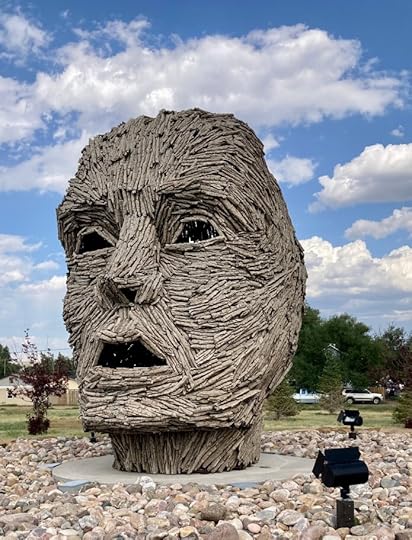
August 22, 2023
Barns End

I’ve got barns on my mind. I’m driving across Illinois on 88 West. This is corn country. On this bright sunny afternoon, there’s a lot of amber waving going on. The fields run from the edge of the road to the horizon. Amidst clusters of trees far into the countryside, barns. Farms with enough shade to keep a farm family cool in the middle of summer. It’s 130 miles to the Iowa border, where we’ll see more barns. Here we pass what seems like hundreds of them.
Raised in a one-stoplight farm town, I’m keen on barns. My paternal grandfather had a barn. My brother and I climbed up into the hay mow, we stood next to him when he sat beside a cow and milked it. He invited us to pull its udders. We inhaled the sweet scent of milk and hay and manure. A sensory overload like that gets imprinted on your memory, indelibly.
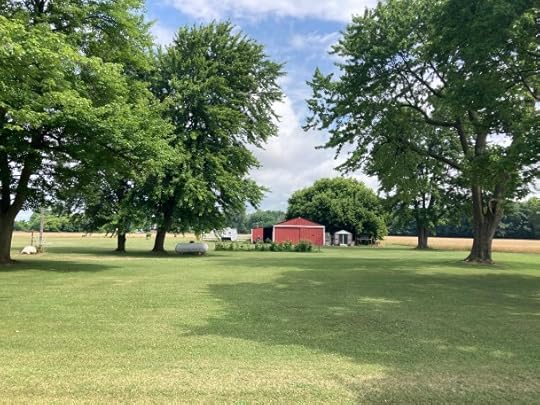
A few months ago I drove by my grandparents’ old farm. The house is gone. The barn is gone. The driveway, lined with tall leafy maple trees, is still there and leads to the back of the lot, where there is a junior barn. It’s red, which is a nice gesture. It’s a pole barn, a modern structure, more garage than barn. Behind it, at the edge of what used to be pasture for my grandfather’s six cows, is the back (and only) nine holes of The Ridge Golf Course. On their Facebook page these amenities are announced: “We offer a driving range and golfing with pull carts and gas carts. Cash and check only! Tentative ho.” I’m not sure about the “tentative ho,” what “ho” is coming, when it will get there. These days every town, even a small farm town like Breckenridge, needs a golf course.
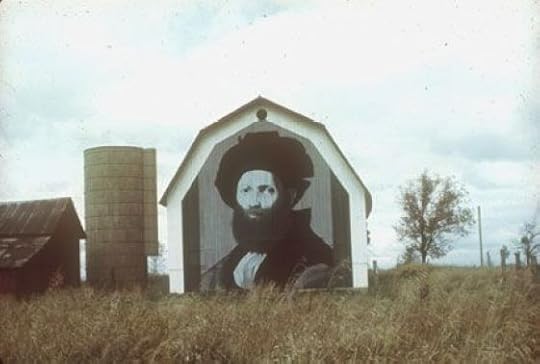
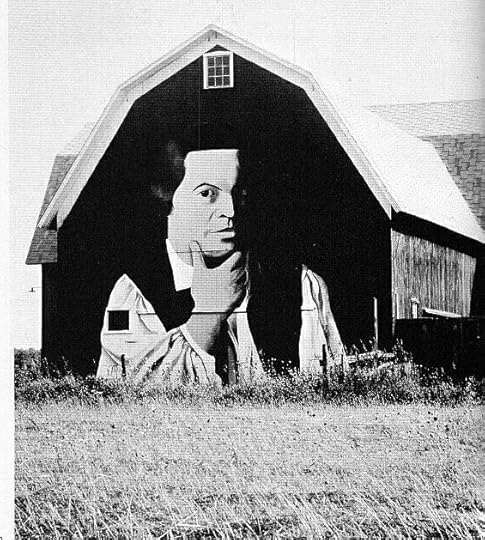
In the 70’s I drove down US 23 to university and back, passing a couple barns that served as palates. Around Fenton an art professor named Doug Tyler painted murals on the side of barns. One I remember was the image of Raphael’s Castiglione. I’m pretty sure on another barn there was a Mona Lisa. What I didn’t get then, but understand now, was that barns were evolving. By that I mean emptying. Georgia O’Keefe spent summers with her husband in upstate New York and, departing from her paintings of flowers, depicted barns. Ends of Barns these paintings are called. She saw something iconic in them. I wonder if she saw also their coming obsolescence.
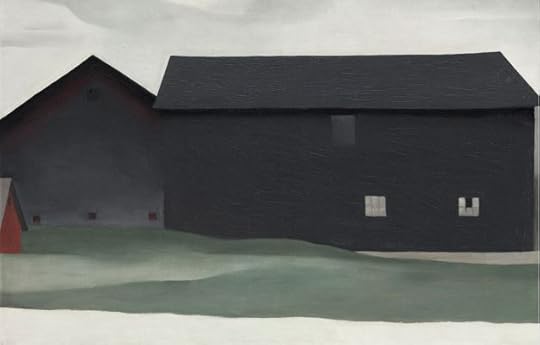
A few summers ago we attended a wedding in northern Michigan, with a reception in a barn. Wedding barns, I guess, are becoming a thing. It was cold that night. The wind blew through the cracks in the siding. But you had to think, Of course, the ideal place for a party. We had a barn dance. It was a great party, a regular barn burner. When I was a kid I imagined some day I would have a roll in the hay, enjoy a barn tryst, which now seems fond and foolish. Hay is prickly and dusty. But that’s how barn life played into my imagination.
Crossing 88 West toward Iowa, we drive in the direction of a warm front. A hot front. When we stop in Des Moines it will be 95 degrees. Along 88 many of the barn roofs are white. I mean blinding bright white. In some cases whole barns are bright white, which I think must be part of a heat management retro-fitting of barns. There are red roofs, and silver and gray and green and brown. But the white roof is so pervasive,
I wonder if there’s a government program helping farmers preserve these structures, make a future for them. I don’t want to imagine farm country without barns. I wonder if Michigan barn roofs are going white like these are. Back home in a few weeks, we’ll have to have a little barn crawl, go barn hopping to see. Right now between Bay City and West Branch, the fields look just like those on this Illinois interstate. We’ll have to drive up North pay attention to barns.

August 19, 2023
In Defense of Fiddling

This morning I was reminded of Marc Maron and JB Smoove’s wacky conversation about fiddling, on Maron’s WTF podcast.
I was outside early, like 5:00 a.m. I take short walks around the house at that time, lighting the way with a small flashlight, careful to stay on the sidewalk to keep my feet dry. It’s a simple, low-level thrill to stand outside in total darkness and look up at the sky. The flashlight probably makes me look sneaky. A neighbor looking out the window might mistake me for a prowler. But at that hour their houses are dark. I have the night all to myself. If need be, and if there’s a partial moon or less, or better yet no moon in the sky, I go to the edge of the driveway and pee in the bushes, feeling like a natural man.
This particular morning I was outside because, back inside the house, having my first cup of coffee, I’d heard the swishing sound of our sprinkling system going on. I don’t trust the system. It’s irrational not to, I know. I programmed it, I’ve tested it in broad daylight. It works. At 5:00 a.m. it starts on the front yard and works its way around the house, ten minutes on each station, three days a week. But out there, under the cover of darkness, I picture busted sprinkler heads and water squirting straight in the air, or heads designed to rotate that are stuck gushing water in one direction, an appalling waste of water, an irritating waste of money.
I went outside to investigate, sweeping across the front yard with my little light. All systems go. Next I entered the garage under the cover of darkness, lighting my way to the system control panel, opened the box and saw: station 6, two minutes of water remaining.
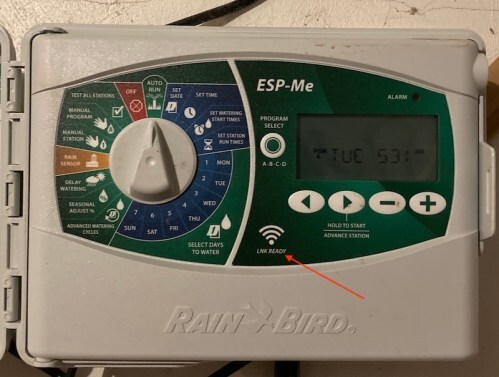
As always, I noticed the wi-fi icon, next to it LNK READY. An invitation to modern-modem man. I should fiddle with this thing, I thought to myself.
Fiddling, according to Maron and Smoove, is an artless, dicey, often doomed investigation that involves taking something apart. “You gotta separate fiddling around with it from fixing it,” Smoove notes. To which Maron adds, “If you’re not a professional fiddler, you’re going to have a mess, and you’ll have to have a fiddler put it back together.”
I wanted to fiddle with the irrigation system because I might want to control it with my phone. For that to happen, the control panel needs to shake hands with the wireless signal in our house, which will enable a second digital handshake, between the control panel with an app on my phone.
LNK READY. There it was. But was I ready?

Behind the knobs and display, I got to the guts of the system. Lots of wires. I do not love wires. Only a fool fiddles with electricity. I found red, green, yellow, orange, tan, and black wires. In the system’s little door, this invitation: “REMOTE accessory.”
All I needed was the Rain-Bird LNK2WIFI WiFi Module – 2nd Generation LNK WiFi – Compatible with All WiFi Controllers Including ESP-ME3, ESP-TM2, ESP-Me WiFi.
Sounded like fun. Fiddle-worthy? How hard could it be?
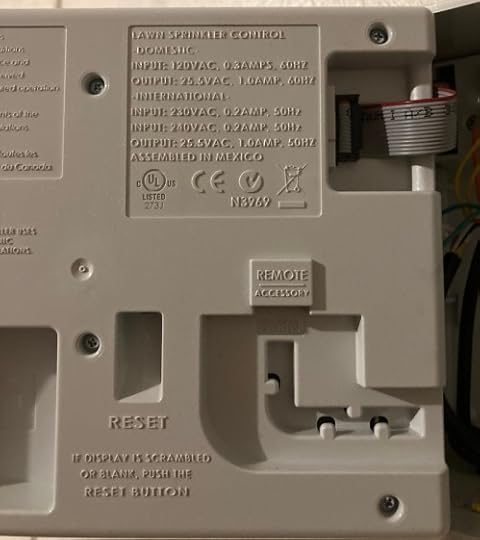
I have some experience with this stuff. I was an early adopter teaching writing with computers at the college. This was before Windows. At the time there was the pre-Mac Apple world of computing and there was the DOS world. Pre-Mac Apple got an early lock on the education market. In the division in which I taught, we had two Apple computers—for 36 full-time instructors and twice as many part-time.
In schools back then–this would have been the early 80’s–you would see one computer, usually an Apple, in the back of a classroom. It was a sign of progress and innovation, I think, enabling schools to boast: we’re thinking about the future: we have a computer in every classroom. The problem was what to do with it. Kids, more often kids than teachers, fiddled with the machines, figuring out how to have fun. It took decades for pedagogy to catch up with tech.

The operating systems of these early computers were primitive and code-dense. You had to tell the thing what to do. This was the pre-mouse period of pre-pull-down menu programs. Point and click had not been invented. You told a computer what to do with keystrokes. I wrote a doctoral dissertation on one of the college’s Apple 2GS computers. For every formatting decision I made—italic, bold, underline, bullets, enumerated list, indent, block, left or center justify—there was code you entered into the page, which, if you did it right, the system did not show when you printed your document on the slow, very noisy dot-matrix printer. (It took three hours and two print cartridges to print my dissertation.)
The wizards at the college, and the other early adopters, most of whom were in the business department, went DOS. I taught in one of their labs (there were three total at the time) full of inexpensive clones, DOS machines that my guru friend Micah knew inside out. “Let me show you something cool,” he would say. How to use DOS commands to copy files and move them from a floppy disk to the network, how to format text, how to manage files, create folders, move files between folders, how to delete files.
I fiddled around a lot, acquired enough working knowledge of DOS to be relatively competent and independent. One day fiddling around, I accidentally deleted all the programs, the operating system, and every file from the hard drive on my laptop. I’ll never forget the haunting void on the screen, a blinking DOS prompt (C:\) and nothing else there. Fiddle at your own risk.
#
A universe later, to control our irrigation system with my smart phone, I order the remote accessory I need on Amazon. It arrives the next day. I would rate my confidence level medium-high—I ought to be able to get this thing to work—but I’m careful opening the package and the box. You never know. I’ll fiddle with it. I’ll fiddle around for a couple days. If I can’t get it to work, I’ll put the accessory back in its box, back in its bag, and send it back to Amazon for a full refund. Feeling good about getting my money back. Feeling the annoyance and sting of a digital defeat.
#
Recently the Wall Street Journal took American universities to task. “Colleges Spend Like There’s No Tomorrow.” The Journal looked at financial statements at 50 state universities nation-wide and found that spending increased on average by 32 percent from 2002 to 2022. Is 32 percent a lot? A cursory look at city, state, and federal general funds would find a similar (if not greater) increase over 20 years. Do institutions spend like there’s no tomorrow? Much of this spending occurs because there will be a tomorrow, and institutions make plans, and expenditures, to be ready for it.
For example, as an early adopter of computer tech in the classroom, I was asked to attend a conference to learn more about this new thing at the time called the Internet. The academic VP was preparing for the future.
At this point, I think I was still dialing up AOL at home. At the college we now had mice in a few glitchy networked classrooms, pull-down menus, laser printers. And Micah.
Go, the academic VP said to me, and learn what you can.
What was the Internet? How did we get it? What would we do with it when we got it? It was coming. We needed to get ready for it. So I flew to Research Triangle in North Carolina, where I was handed a 700-page tome, everything you needed to know about the Internet and were afraid to ask. Sessions were presided over by geeky tech types who provided detailed, often tortured answers to these questions in vaguely English terms. Evidently I needed to know about BPS, Bitnet, FTP, Gopher, IRC, PPP, TCP/IP, Telnet, USENET, ethernet, LAN, WAIS, HTML, http. It was overwhelming. I slept two nights in a hotel, ate six meals, drank a few beers with a few other be-nighted instructors, and came home overwhelmed and confused.
Well? the academic VP said to me back at school.
This is going to take a while, I said, this Internet thing. We would need a whole team of fiddlers. And we would have to spend some money.
#
The package arrives on our porch around 8:00 p.m. The Rain-Bird LNK2WIFI WiFi Module is a little thing, about the size of a pad of butter. I figure it will be best to fiddle with setup in broad daylight.

Next day, in a couple hours, I get it to work. Kind of. The controller shakes hands with our wireless signal. I download the app that shakes hands with the controller. “Congratulations!” the app tells me. “You can now access this controller from anywhere in the world.” I’ll have to learn the app, its icons, its controls, its options. When I do, theoretically, in downtown Detroit or downtown anywhere, provided my phone works, I will be able to tell our sprinkling system to wake up and sprinkle or take the day off. That’s what I want. That’s what I think I want.
The following day, with rain in the forecast, I figure I will make some digital adjustments in the system program. Please don’t sprinkler in the rain. I open the Rain Bird app, tap on it, and see an error message. The app can’t connect, I should check my internet connection, possibly the wireless signal is weak, re-boot my phone, re-boot Rain-Bird LNK2WIFI WiFi Module. Get help.
Out in the garage that morning, I sit on an overturned Home Depot bucket with my laptop on my knees, fiddling with the control panel and the interface.
I might be able to fix it, to get it right, if I buy a range extender to make sure I have robust Internet service in the garage. That will be another thing to fiddle with. How hard do I want to work? And for what? What I have learned from the Rain-Bird LNK2WIFI WiFi Module, when the app is working, is that the control panel on the wall in the garage detects rain on its own and gets along perfectly well without interfacing with me.
I pack up Rain-Bird LNK2WIFI WiFi Module and send it back to Amazon.
Nice try.
It’s digital defeat. And I’m okay with that. It was fun fiddling. The day I return Rain-Bird LNK2WIFI WiFi Module, a package arrives in the mail with my Vital Fitness Tracker, which will count steps and calories burned, distance walked; monitor sleep, heart rate, and blood pressure. I download the app. I take a long walk (15454 steps!). I go to bed eager to see sleep data. The next morning this message appears on the app. “No sleep data. Did you wear the device to bed?”
Yes, I did. So, I guess I’ll have to fiddle with it.
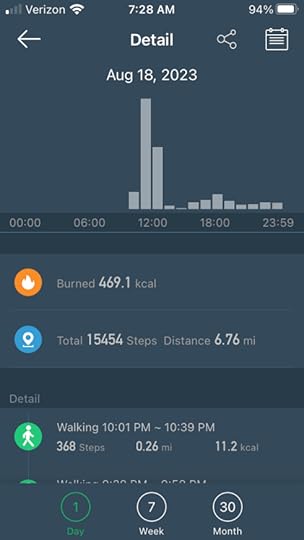
July 26, 2023
Wherefore Oodles

An oodle sounds a lot like a Monty Python character. You can imagine John Cleese dressed up as a woman, saying, “Hello, my name is Ann Oodle. I am an expert on snakes.”
Funny thing about oodle. It’s one of those words in English that has no singular. Think trousers, butterfingers, hijinks, spartypants, gadzooks. I’ve got dibs on the tinsnips. But I never have a dib on anything, not even a tinsnip. And I’ll never see oodle.
In its normal plural form, oodles means a bunch, a lot, a great many, a ton. In the sentences I harvested from Facebook recently (thank you, generous friends) I saw oodles of poodles, oodles of noodles, oodles of oodles. My friend Kate Cunningham brought Kurt Vonnegut to my attention. This from his Breakfast of Champions: “I can have oodles of charm when I want to. A lot of people have oodles of charm. Dwayne Hoover had oodles of charm.”
Oodles of charm sounded strange to me (evidently it did not to Kurt Vonnegut). Dwayne Hoover has a lot of charm, tons of charm. But oodles?
We distinguish, whether we know it or not, between count nouns and mass nouns in English. Clothes vs dresses, for example. Lots of clothes. Not ten clothes.
But it seems like oodles swings both ways, works with nouns that have mass and nouns we count. Some countable samples harvested from Facebook: oodles of cucumbers, oodles of cuddles, oodles of responses, oodles of buttons, oodles of wrinkles, oodles of seats. All countable. Then these: oodles of melted chocolate, oodles of junk, oodles of fun, oodles of tolerance, oodles of patience. Oodles of charm. Nothing to count here.
Oodles is cute (I feel slightly embarrassed using it). Its origin is uncertain. It’s slangy, informal. Probably 19th century, possibly Texas or Tennessee. And it could be an offshoot of kit and caboodle.
Looking into its origins I stumbled upon a site where writers reflected on its use. One recalls: “I once used oodles in an essay in school and got points off because ‘it wasn’t a real word.’”
 :
:Ugh, English teachers, how do we survive the damage you do? Another writer: “Granny used to always say ‘I have oodles and gobs of work to do.’” Then there’s this: “Hollywood star Harrison Ford might be getting on in years, but he still has oodles of appeal.” The consensus among writers seemed to be that oodles is cool. One cheeky individual said, “You should definitely say oodles more. Preferably at academic conferences.”
Possible alternatives to oodles these writers endorsed: boatload, shipload, shitload, butt load, shit ton.
Gotta love gobs.
Maybe because oodles ends in -s, I want it attached to a count noun. “Oodles of appeal” just sounds off to me. But then gobs of appeal does not. Harrison Ford has gobs of appeal. And I’m okay with that. So this oodles thing, it’s not scientific. It’s personal.
Of the samples I collected, 55 percent linked oodles to a count noun; 45 percent to a mass noun. So maybe, just maybe, oodles more frequently precedes a count noun. If we really wanted to do science, it would take an ambitious research project to verify this count/mass thing, a survey of oodles use in English across the country, in the English speaking world. We would need a grant.
Serious research costs oodles of money.
July 18, 2023
Sleepwalker: A Review

I woke up this morning thinking about Sleepwalker, Linda K. Sienkiewicz’s book of poems, considering what to say about it, wondering how to find the words sufficiently to honor it. This is a book about grief, about the unthinkable loss of a child who takes his life, about how to live with that. I had just finished reading a book about homes blown to smithereens by a hurricane. Lying in bed I pictured a house, her home, flying into the air, spinning about and coming apart, forgetting that was the image on the cover of her book. With each poem in this book, she drives a stake into the ground, holding the house in place, keeping it from flying apart.
There is heartbreak throughout, the chaos of emotion intricately presented. In a poem about shipwreck (“What Every Mother Hopes For”) a boy miraculously survives and comes home. In another poem, in an orgy of anger (“Gone: A Dream”) the boy leaves home, the mother watching from a second story window, wanting to protect him, to help him, “I want to jump from the window after him / but I’m tangled in the curtains.” Helplessness pervades the collection. In the title poem, “Sleepwalker,” the mother connects–”every night I give him a kiss / to wear on a chain around his neck”–while realizing the separation, a gulf she cannot cross–”I am on the other side of his journey.”
And the discovery, in “The Second Worst Thing,” rendered in agonizing minimal detail:
The police took
your laptop
I don’t know what else
and then
you
Along with heartbreak (a thud deep in a mother’s womb, as Sienkiewicz describes it), there is the endless return and re-examination, and there is no answer, no reply. There is only continuation. “Once you let go, the body takes over,” she writes. Nothing matters, and tomorrow comes too soon.
Love is an ache. In these marvelous poems, the reader aches with her.
Published by Finishing Line Press
Stuff happens, then you write about it
- Rick Bailey's profile
- 31 followers



